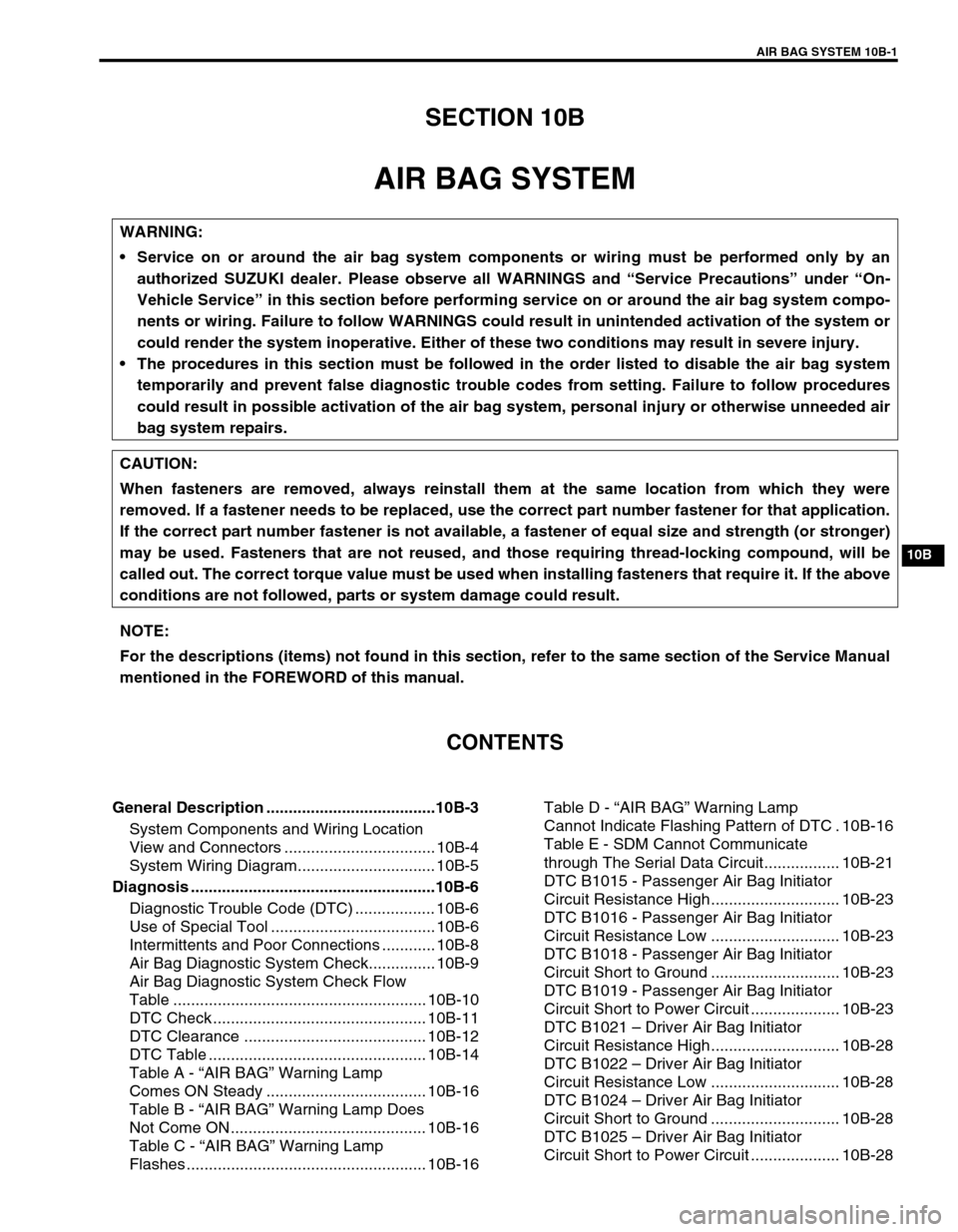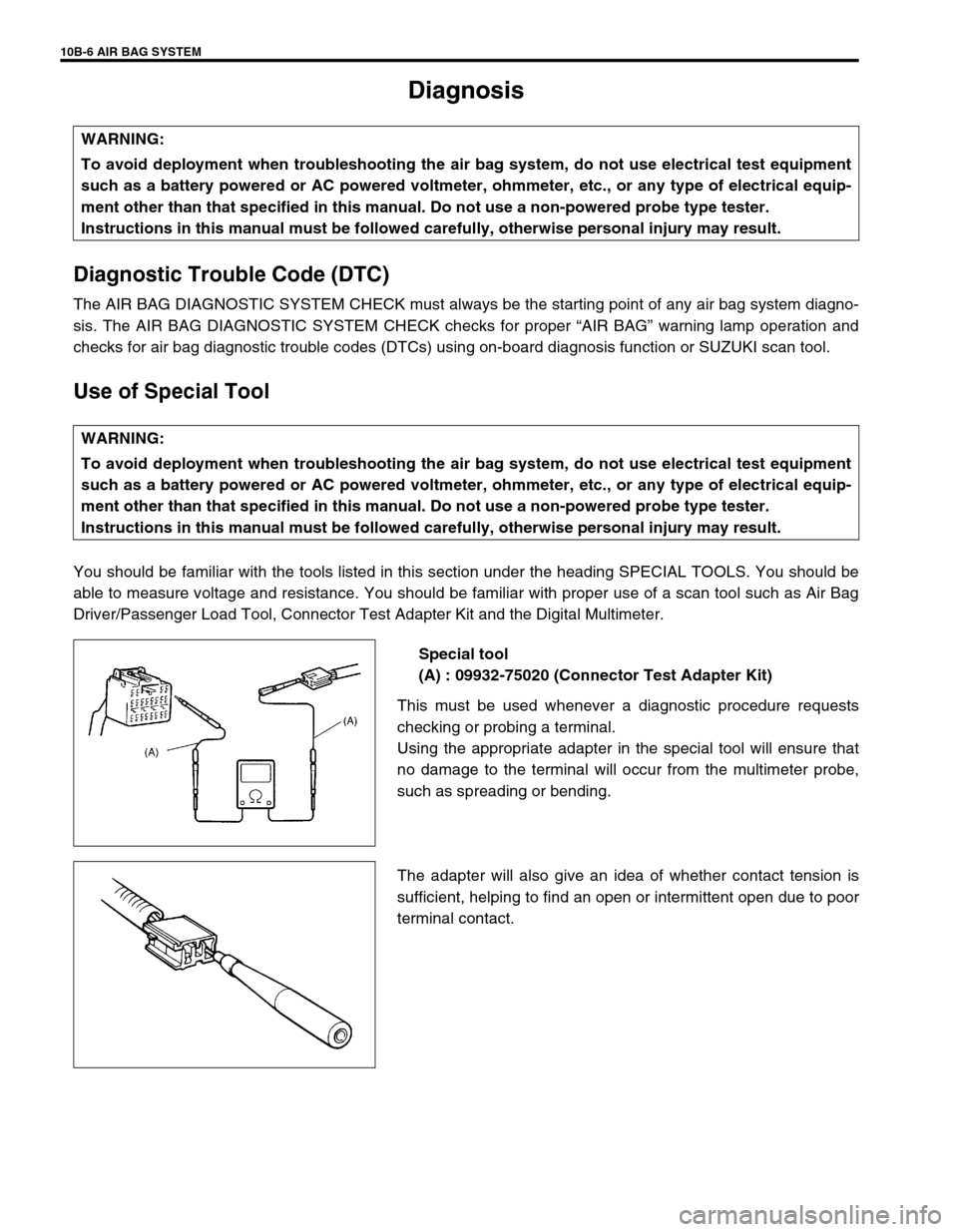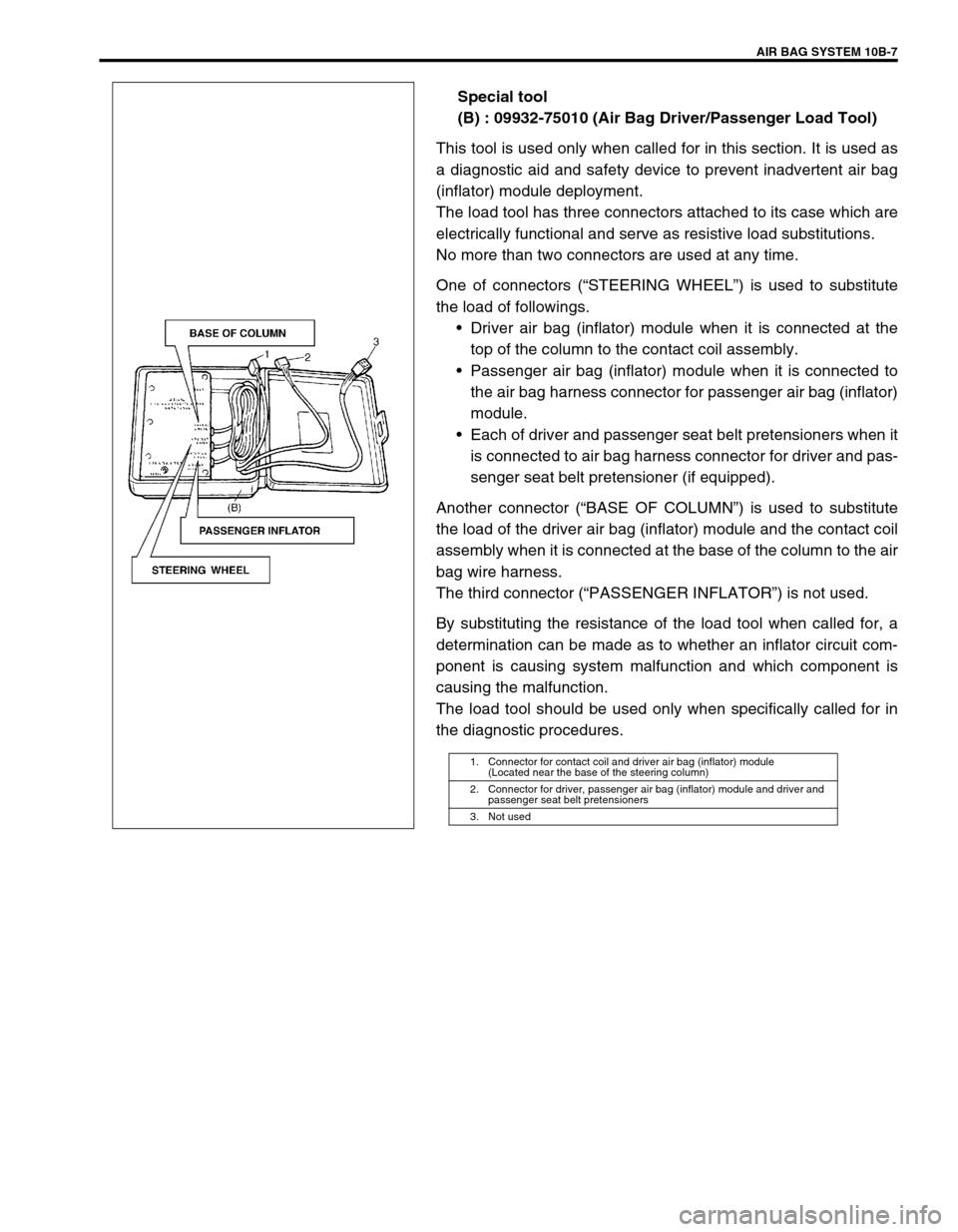2001 SUZUKI GRAND VITARA Section 8a
[x] Cancel search: Section 8aPage 571 of 656

10A-2 SEAT BELT
On-Vehicle Service
Service Precautions
Service and diagnosis
Before servicing or replacing seat belts, refer to following precautionary items.
•Seat belts should be normal relative to strap retractor and buckle portions.
•Keep sharp edges and damaging objects away from belts. Avoid bending or damaging any portion of belt
buckle, latch plate and ELR.
•Do not bleach or dye belt webbing. (Use only mild soap and lukewarm water to clean it.)
•When installing a seat belt anchor bolt, start bolt by hand to prevent cross-threading.
•Use only the correct seat belt anchor bolts and screws and tighten to the correct torque value.
•Do not attempt any repairs on retractor mechanisms or retractor covers. Replace defective assemblies with
new replacement parts.
•Keep belts dry and clean at all times.
•If there exist any parts in question, replace such parts.
•Replace belts whose webbing is cut or otherwise damaged.
•Do not put anything into trim panel opening which seat belt webbing passes through.
For Seat Belt with Pretensioner
Refer to “SERVICE AND DIAGNOSIS” of “SERVICE PRECAUTIONS” under “ON-VEHICLE SERVICE” in Sec-
tion 10B.
Disabling air bag system
Refer to “DISABLING AIR BAG SYSTEM” of “SERVICE PRECAUTIONS” under “ON-VEHICLE SERVICE” in
Section 10B.
Enabling air bag system
Refer to “ENABLING AIR BAG SYSTEM” of “SERVICE PRECAUTIONS” under “ON-VEHICLE SERVICE” in
Section 10B.
Handling and storage
Refer to “HANDLING AND STORAGE” of “SERVICE PRECAUTIONS” under “ON-VEHICLE SERVICE” in Sec-
tion 10B.
Disposal
Refer to “DISPOSAL” of “SERVICE PRECAUTIONS” under “ON-VEHICLE SERVICE” in Section 10B. WARNING:
If replacing seat belt is necessary, replace buckle and ELR (or webbing) together as a set. This is for
the reason of ensuring locking of tongue plate with buckle. If these parts are replaced individually,
such a locking condition may become unreliable. For this reason, SUZUKI will supply only the spare
buckle and ELR (or webbing) in a set part.
WARNING:
When performing service on or around air bag system components or air bag system wiring, disable
the air bag system. Refer to “DISABLING AIR BAG SYSTEM” of “SERVICE PRECAUTIONS” under
“ON-VEHICLE SERVICE” in Section 10B.
Failure to follow procedures could result in possible air bag activation, personal injury or unneeded
air bag system repairs.
Page 573 of 656

10A-4 SEAT BELT
REMOVAL
1) Disconnect negative cable at battery.
2) Disable air bag system referring to “DISABLING AIR BAG SYSTEM” of “SERVICE PRECAUTIONS” under
“ON-VEHICLE SERVICE” in Section 10B, if necessary.
3) Remove front pillar lower trim.
4) Disconnect Yellow connector for seat belt pretensioner, if necessary.
a) Release locking of lock lever.
b) After unlocking, disconnect to connector.
5) Remove front seat belts from the vehicle.
INSPECTION
Seat belts and attaching parts can affect the vital components and systems of a vehicle. Therefore, they should
be inspected carefully and replaced with genuine parts only.
Seat belt
•The seat belt webbing or strap should be free from damage.
•Fully extend the seat belt to make sure there are no twists or tears in it.
Retractor assembly
1) Let the seat belt retract fully to confirm its easy retraction.
•The retractor assembly should lock webbing when pulled quickly.
•The retractor assembly should lock webbing even when tilted (approx. 15°) toward the fore and aft or right
and left directions.
2) Check retractor assembly with seat belt pretensioner appearance visually for following symptoms and if any
one of them is applicable, replace it with a new one as an assembly.
•Pretensioner has activated.
•There is a crack in seat belt pretensioner (retractor assembly).
•Wire harness or connector is damage.
•Seat belt pretensioner (retractor assembly) is damaged or a strong impact (e.g., dropping) was applied to it.
Anchor bolt
•Inspect all seat belt anchor bolts to verify that they are secure.
•All anchor bolts should be secure and torqued to specification.
Belt latch
•Belt latch should be secure when latched.
•Inspect the seat belt buckle, ensuring that it locks and unlocks easily.
•After buckling the seat belt, tug sharply on the belt, checking that the buckle remains locked.WARNING:
Never measure resistance of pretensioner or disassem-
ble it. Otherwise, personal injury may result.
CAUTION:
If seat belt pretensioner (retractor assembly) was
dropped from a height of 30 cm (1 ft) or more, it should
be replaced.
Page 574 of 656

SEAT BELT 10A-5
Seat belt switch
Check driver side seat belt strap switch for continuity by using
ohmmeter.
Seat belt strap switch specification
Without inserted buckle tongue to buckle catch:
Terminal “A” and “B” : Continuity
With inserted buckle tongue to buckle catch:
Terminal “A” and “B” : No continuity (∞Ω
∞Ω∞Ω ∞Ω)
INSTALLATION
Install in reverse order of removal, noting the followings.
•Seat belt anchor bolts should have an unified fine thread (7/16-20 UNF). Under no circumstances should
any different sized or metric screw threads be used.
•Connect Yellow connector for seat belt pretensioner securely and fit seat belt pretensioner connector onto
front pillar lower panel, if necessary.
a) Connect connector
b) Lock connector with lock lever
•Enable air bag system referring to “ENABLING AIR BAG SYSTEM” under “SERVICE PRECAUTIONS” in
Section 10B, if necessary.
1. Buckle tongue
2. Buckle catch
Page 575 of 656

10A-6 SEAT BELT
Second Rear Seat Belt
REMOVAL
Refer to the figure above to remove rear seat belts.
INSPECTION
Check second rear seat belt in the same way as when inspecting front seat belt except pretesioner inspection.
(Refer to “FRONT SEAT BELT” in this section.)
INSTALLATION
Install in reverse order of removal, noting the followings.
•Seat belt anchor bolts should have an unified fine thread (7/16-20 UNF). Under no circumstances should
any different sized or metric screw threads be used. WARNING:
Be sure to read “SERVICE PRECAUTIONS” in this section before starting to work and observe every
precaution during work.
1. Upper anchor 4. Buckle
2. Lower anchor Tightening Torque
3. Retractor assembly
2
35 N·m (3.5 kg-m, 25.5 lb-ft)
35 N·m (3.5 kg-m, 25.5 lb-ft)
35 N·m (3.5 kg-m, 25.5 lb-ft)
35 N·m (3.5 kg-m,
25.5 lb-ft)
4
4
4
Page 576 of 656

SEAT BELT 10A-7
Third Rear Seat Belt (If Equipped)
REMOVAL
Refer to the figure above to remove rear seat belts.
INSPECTION
Check third rear seat belt in the same way as when inspecting second rear seat belt. (Refer to “SECOND REAR
SEAT BELT” in this section.)
INSTALLATION
Install in reverse order of removal, noting the followings.
•Seat belt anchor bolts should have an unified fine thread (7/16-20 UNF). Under no circumstances should
any different sized or metric screw threads be used. WARNING:
Be sure to read “SERVICE PRECAUTIONS” in this section before starting to work and observe every
precaution during work.
1. Upper anchor 4. Buckle
2. Lower anchor Tightening Torque
3. Retractor assembly
35 N·m (3.5 kg-m,
25.5 lb-ft)
35 N·m (3.5 kg-m,
25.5 lb-ft)
35 N·m (3.5 kg-m, 25.5 lb-ft)
4
4
(a)
(a)
Page 578 of 656

AIR BAG SYSTEM 10B-1
10B
SECTION 10B
AIR BAG SYSTEM
CONTENTS
General Description ......................................10B-3
System Components and Wiring Location
View and Connectors .................................. 10B-4
System Wiring Diagram............................... 10B-5
Diagnosis .......................................................10B-6
Diagnostic Trouble Code (DTC) .................. 10B-6
Use of Special Tool ..................................... 10B-6
Intermittents and Poor Connections ............ 10B-8
Air Bag Diagnostic System Check............... 10B-9
Air Bag Diagnostic System Check Flow
Table ......................................................... 10B-10
DTC Check ................................................ 10B-11
DTC Clearance ......................................... 10B-12
DTC Table ................................................. 10B-14
Table A - “AIR BAG” Warning Lamp
Comes ON Steady .................................... 10B-16
Table B - “AIR BAG” Warning Lamp Does
Not Come ON ............................................ 10B-16
Table C - “AIR BAG” Warning Lamp
Flashes ...................................................... 10B-16Table D - “AIR BAG” Warning Lamp
Cannot Indicate Flashing Pattern of DTC . 10B-16
Table E - SDM Cannot Communicate
through The Serial Data Circuit................. 10B-21
DTC B1015 - Passenger Air Bag Initiator
Circuit Resistance High............................. 10B-23
DTC B1016 - Passenger Air Bag Initiator
Circuit Resistance Low ............................. 10B-23
DTC B1018 - Passenger Air Bag Initiator
Circuit Short to Ground ............................. 10B-23
DTC B1019 - Passenger Air Bag Initiator
Circuit Short to Power Circuit .................... 10B-23
DTC B1021 – Driver Air Bag Initiator
Circuit Resistance High............................. 10B-28
DTC B1022 – Driver Air Bag Initiator
Circuit Resistance Low ............................. 10B-28
DTC B1024 – Driver Air Bag Initiator
Circuit Short to Ground ............................. 10B-28
DTC B1025 – Driver Air Bag Initiator
Circuit Short to Power Circuit .................... 10B-28 WARNING:
Service on or around the air bag system components or wiring must be performed only by an
authorized SUZUKI dealer. Please observe all WARNINGS and “Service Precautions” under “On-
Vehicle Service” in this section before performing service on or around the air bag system compo-
nents or wiring. Failure to follow WARNINGS could result in unintended activation of the system or
could render the system inoperative. Either of these two conditions may result in severe injury.
The procedures in this section must be followed in the order listed to disable the air bag system
temporarily and prevent false diagnostic trouble codes from setting. Failure to follow procedures
could result in possible activation of the air bag system, personal injury or otherwise unneeded air
bag system repairs.
CAUTION:
When fasteners are removed, always reinstall them at the same location from which they were
removed. If a fastener needs to be replaced, use the correct part number fastener for that application.
If the correct part number fastener is not available, a fastener of equal size and strength (or stronger)
may be used. Fasteners that are not reused, and those requiring thread-locking compound, will be
called out. The correct torque value must be used when installing fasteners that require it. If the above
conditions are not followed, parts or system damage could result.
NOTE:
For the descriptions (items) not found in this section, refer to the same section of the Service Manual
mentioned in the FOREWORD of this manual.
Page 583 of 656

10B-6 AIR BAG SYSTEM
Diagnosis
Diagnostic Trouble Code (DTC)
The AIR BAG DIAGNOSTIC SYSTEM CHECK must always be the starting point of any air bag system diagno-
sis. The AIR BAG DIAGNOSTIC SYSTEM CHECK checks for proper “AIR BAG” warning lamp operation and
checks for air bag diagnostic trouble codes (DTCs) using on-board diagnosis function or SUZUKI scan tool.
Use of Special Tool
You should be familiar with the tools listed in this section under the heading SPECIAL TOOLS. You should be
able to measure voltage and resistance. You should be familiar with proper use of a scan tool such as Air Bag
Driver/Passenger Load Tool, Connector Test Adapter Kit and the Digital Multimeter.
Special tool
(A) : 09932-75020 (Connector Test Adapter Kit)
This must be used whenever a diagnostic procedure requests
checking or probing a terminal.
Using the appropriate adapter in the special tool will ensure that
no damage to the terminal will occur from the multimeter probe,
such as spreading or bending.
The adapter will also give an idea of whether contact tension is
sufficient, helping to find an open or intermittent open due to poor
terminal contact. WARNING:
To avoid deployment when troubleshooting the air bag system, do not use electrical test equipment
such as a battery powered or AC powered voltmeter, ohmmeter, etc., or any type of electrical equip-
ment other than that specified in this manual. Do not use a non-powered probe type tester.
Instructions in this manual must be followed carefully, otherwise personal injury may result.
WARNING:
To avoid deployment when troubleshooting the air bag system, do not use electrical test equipment
such as a battery powered or AC powered voltmeter, ohmmeter, etc., or any type of electrical equip-
ment other than that specified in this manual. Do not use a non-powered probe type tester.
Instructions in this manual must be followed carefully, otherwise personal injury may result.
Page 584 of 656

AIR BAG SYSTEM 10B-7
Special tool
(B) : 09932-75010 (Air Bag Driver/Passenger Load Tool)
This tool is used only when called for in this section. It is used as
a diagnostic aid and safety device to prevent inadvertent air bag
(inflator) module deployment.
The load tool has three connectors attached to its case which are
electrically functional and serve as resistive load substitutions.
No more than two connectors are used at any time.
One of connectors (“STEERING WHEEL”) is used to substitute
the load of followings.
•Driver air bag (inflator) module when it is connected at the
top of the column to the contact coil assembly.
•Passenger air bag (inflator) module when it is connected to
the air bag harness connector for passenger air bag (inflator)
module.
•Each of driver and passenger seat belt pretensioners when it
is connected to air bag harness connector for driver and pas-
senger seat belt pretensioner (if equipped).
Another connector (“BASE OF COLUMN”) is used to substitute
the load of the driver air bag (inflator) module and the contact coil
assembly when it is connected at the base of the column to the air
bag wire harness.
The third connector (“PASSENGER INFLATOR”) is not used.
By substituting the resistance of the load tool when called for, a
determination can be made as to whether an inflator circuit com-
ponent is causing system malfunction and which component is
causing the malfunction.
The load tool should be used only when specifically called for in
the diagnostic procedures.
1. Connector for contact coil and driver air bag (inflator) module
(Located near the base of the steering column)
2. Connector for driver, passenger air bag (inflator) module and driver and
passenger seat belt pretensioners
3. Not used